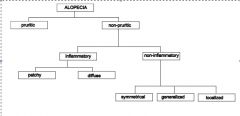![]()
![]()
![]()
Use LEFT and RIGHT arrow keys to navigate between flashcards;
Use UP and DOWN arrow keys to flip the card;
H to show hint;
A reads text to speech;
14 Cards in this Set
- Front
- Back
|
How could you describe alopecia?
|

PRURITIC -> alopecia 2ndary
NON-PRURITIC: inflammatory patchy: eg. pyoderma, demodecosis, dermatophytosis, sebaceous adenitis, autoimmune... inflammatory diffuse: eg. demodecosis, autoimmune, paraneoplastic, seb. adenitis non-inflammatory symetrical: eg. endocrine, cyclic flank alopecia, pattern alopecia non-inflammtory generalised: eg. congenitial hypertrichosis, colour dilution alopecia, folicular aplasia non-inflammatory: eg. post clipping, psychogenic |
|
|
How would you diagnose demodecosis?
|
Multiple deep skin scrapings: squeeze pus out of follicles and scrape to get capillary bleeding. Examine in oil under a coverslip
|
|
|
What is your approach to treating demodecosis?
|
treatment can be long and expensive -> good client communication
localised mild -> generally resolve spontaneously -> monitor generalised: clip & clean lesions address underlying cause NO CORTICOSTEROIDS! AB &/or ketoconazole for 2ndary infection generalised juvenile = hereditary -> don't breed dam, sire & siblings acaricidal therapy: Amitraz topical once weekly - not if hyperA or DM, must clip coat Ivermectin daily PO - not herding breeds Milbemysin oxime PO daily - rare neuro effects Moxidectin PO or Advocate weekly - breed reactions Doramectin weekly SC - no adverse effects reported |
|
|
Which dermatophytes cause the majority of ringworm infections?
How long can their spores survive in the environment? |
Microsporum canis (90%), Microsporum gypseum & Trichophyton mentagrophytes
up tp 18months |
|
|
How would you approach diagnosis of dermatophytosis?
|
Wood’s Lamp UV fluorescence: Only 50% M. canis fluoresce
Trichogram: examination of hair shafts -> may show distortion Fungal Culture: necessary for definitive diagnosis Biopsy: submit unprocessed tissue aseptically for culture and formalin preserved tissue for histopathology |
|
|
How would you treat dermatophytosis topically?
|
Topical therapy reduces contamination of the hair coat and thus environmental contamination
whole-body dipping & shampooing or rinsing, twice weekly, 10min contact time lime-sulphur at 1:16 dilution enilconazole (Emaverol wash) miconazole (Malaseb shampoo) |
|
|
How would you treat dermatophytosis systemically?
|
always required!
griseofulvin PO bid - arrests fungal cell division antiinflammatory & immunomodulatory, not in FIV positive cats ketoconazole sid - interferes with membrane and ergosterol synthesis, not recommended in cats itraconazole sid - interferes with membrane and ergosterol synthesis, better tolerated but more expensice, suitable for cats incl. kittens terbinafine sid - interferes with ergosterol synthesis, well tolerate, cats & dogs |
|
|
Which environmental contaminants are effective against dermatophytes?
|
1:33 lime sulphur, 0.2% enilconazole and 1:10 to 1:100 household bleach
|
|
|
What dermatological signs are associated with canine hypothyroidism?
|
variable, but the classic picture is a dry, brittle coat that is easily epilated
symmetrical alopecia hyperpigmentation “rat tail |
|
|
What dermatological signs are associated with canine hyperadrenocorticism?
|
classically a thin coat with symmetrical trunkal alopecia,
thin skin +/- calcinosis cutis and/or secondary pyoderma delayed wound healing |
|
|
What dermatological signs are associated with hyperoestrogenism?
|
bilaterally symmetrical alopecia especially perineum, inguinal and flank regions
hyperpigmentation, comedones, scaling, pyoderma, pruritus may be observed |
|
|
What dermatological signs are associated with Alopecia X?
|
Initially the primary guard hairs are lost, giving a woolly coat, with eventual secondary hair loss, symmetrical alopecia and hyperpigmentation
The head and extremities are spared and dogs are otherwise healthy |
|
|
Which coat colours predipose to colour dilution alopecia?
|
inherited defect of a subset of young dogs with blue or fawn coat colour dilution, especially Dobermans
The light coloured hairs may be more brittle and fragile, which predisposes to a dull, dry, brittle coat with progressive patchy alopecia Papules may progress to comedones and chronically hyperpigmentation. Diagnosis is by trichogram and histopathology |
|
|
What could be a cause for if bilaterally symmetrical alopecia is non endocrien & non inflammatory?
|
Cyclic recurrent flank alopecia
idiopathic condition of young dogs, marked hyperpigmentation |

